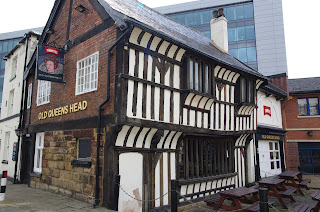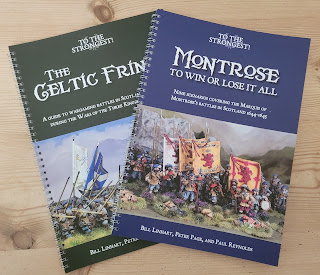Houses of Interest: South Yorkshire
For more Yorkshire 'related stuff' you can find West Yorkshire here, North Yorkshire here, and East Riding here.
The former People's Republic of South Yorkshire saw a little less action than its cousins West, North and East Yorkshire.
Despite the modern appearance of the city, there are a handful of buildings that survive from the time of the wars.
Old Queen’s Head Pub on Pond Street is a fifteenth century timber framed building and the oldest surviving domestic building in Sheffield.
Broom Hall, Broom Hall Road, was home to the Parliamentarian Jessop family. The hall was modernised in the eighteenth century, and bears little resemblance to the house that stood there during the seventeenth century. It is now offices of an architect and a law firm.
Bishops’ House, located in what is now Meersbrook Park, was home to William Blythe, a Parliamentary Commander in the Civil War and one of the men who supervised the demolition of Sheffield Castle in 1648. The house is a museum to Tudor and Stuart life.
Carbrook Hall is allegedly Sheffield's most haunted building; Carbrook Hall was home to Colonel Sir John Bright and it is believed the building was used as a meeting place to plan and coordinate the Parliamentarian siege of Sheffield Castle. Now a branch of a multinational coffee shop chain. There is a display of 'Civil War armour' inside the building: the figure wearing stylised cosplay armour (and shield!) possibly has more in common with a low budget fantasy movie than anything even remotely historical.
Sheffield City Library has a good online guide to researching the Wars in Sheffield, including a downloadable pdf sources guide. You can find it here.
Wentworth Woodhouse in Rotherham was home to the Earl of Strafford. Strafford was executed as a traitor prior to the outbreak of hostilities. The house was largely rebuilt in the eighteenth century, a few remnants of Strafford's house still remain. Most notably the 'yellow bedroom' from whence he is reported to have departed for London, for his execution.
As Charles had reluctantly signed his death warrant he granted him the favour of being beheaded rather than being hung, drawn and quartered. His family were able to take his body and bury it. But where did they bury him?
The Old Holy Trinity Church in Wentworth has a memorial to Strafford. There is also a memorial to Sir John Morris in the church (Sir John was executed in 1649 for his part in commanding the garrison of Pontefract Castle); Sir John had asked to be buried near the grave of his former master Strafford (he had been Strafford's page).
Wentworth Village is very picturesque, with limited parking for visitors. Best to aim for the village car park, then explore the village on foot. Old Holy Trinity Church is a redundant, partially derelict church located very close to the newer Victorian village church.
Or is he buried in an unmarked grave at St John's church, Hooton Roberts? Strafford's widow, Elizabeth, had moved to the Dower House in the village (the building still exists but is now a pub called The Earl of Strafford). Elizabeth died aged 83 in 1688 and asked that she be buried at St John's in an unmarked grave. In 1895 workmen discovered three skeletons near the altar - two women (one showing signs of rickets, Strafford's favourite daughter died aged 16, coincidentally she had rickets) and the skeleton of a man showing signs of severed vertebrae. Curious and curiousier, said Alice.
Or is he buried in an unmarked grave at St John's church, Hooton Roberts? Strafford's widow, Elizabeth, had moved to the Dower House in the village (the building still exists but is now a pub called The Earl of Strafford). Elizabeth died aged 83 in 1688 and asked that she be buried at St John's in an unmarked grave. In 1895 workmen discovered three skeletons near the altar - two women (one showing signs of rickets, Strafford's favourite daughter died aged 16, coincidentally she had rickets) and the skeleton of a man showing signs of severed vertebrae. Curious and curiousier, said Alice.
(St John's and the Earl of Strafford pub, despite having very different postcodes are practically next door to one another.)
Doncaster was fiercely loyal to the King; Charles visited the town on the 18th August 1645 where he was met by great numbers of Yorkshiremen who had rallied to his cause. His son, Charles II would award the town the title of 'Free Borough' in gratitude for Doncaster's allegiance during the Wars. But Doncaster's most important role during the period was in the murder of the Leveller, Colonel Thomas Rainsborough.
In October 1648 Fairfax despatched Rainsborough to Yorkshire to take command of the siege of Pontefract Castle. The officer whom he superseded, Sir Henry Cholmley, complained bitterly of his supersession, and refused obedience to Rainsborough. Rainsborough retired to Doncaster, leaving Cholmley to continue the siege, until Parliament resolved the dispute.
Rotherham itself saw a minor skirmish in May 1643: the Marquis of Newcastle attacked the town's bridge which was defended by the local parliamentarians, including 30 boys from the town's grammar school. Rotherham's museum, Clifton Park Museum, has a small display about the town in the Civil War.
Doncaster was fiercely loyal to the King; Charles visited the town on the 18th August 1645 where he was met by great numbers of Yorkshiremen who had rallied to his cause. His son, Charles II would award the town the title of 'Free Borough' in gratitude for Doncaster's allegiance during the Wars. But Doncaster's most important role during the period was in the murder of the Leveller, Colonel Thomas Rainsborough.
In October 1648 Fairfax despatched Rainsborough to Yorkshire to take command of the siege of Pontefract Castle. The officer whom he superseded, Sir Henry Cholmley, complained bitterly of his supersession, and refused obedience to Rainsborough. Rainsborough retired to Doncaster, leaving Cholmley to continue the siege, until Parliament resolved the dispute.
Thomas took lodgings at an inn in the Market Place. There are a number of different versions of events, but what is common to all versions is that three Royalists rode from Pontefract, and were allowed entry to the town, and then into Rainsborough's rooms. It is believed they intended to kidnap Rainsborough with the intention of using him as a bargaining tool for the release of Sir Marmaduke Langdale, or for more favourable terms at the inevitable capitulation of the castle.
However, the kidnap attempt did not go according to plan and Thomas was brutally murdered. There must have been considerable collusion for the three kidnappers/murderers to be able to enter the town and gain access to Rainsborough's rooms so easily; a number of contemporaneous conspiracy theories exist as to who aided the kidnap attempt from a maid at the inn, to a secret cabal of freemasons opposed to the Levellers.
Many online references to Rainsborough's murder make reference to a plaque marking the event located near House of Fraser on Baxter Gate. No such plaque exists, nor does it appear to have ever existed. The pub in which Rainsborough lodged was in the Market Place, believed to be on the site of what is now Primark.
Doncaster Museum has recently reopened after relocating to a new site, the Danum Gallery, Library and Museum on Waterdale. The new building encloses an older building, and also incorporates the library, an art gallery, the KOYLI regimental museum, a local railway heritage collection (including two steam engines). The museum has in its collection a helmet, some 17th Century pottery, a number of Inn Tokens, and a market charter granted by Richard Cromwell (The Thorne Charter). Strangely no mention of Rainsborough's murder.
Many online references to Rainsborough's murder make reference to a plaque marking the event located near House of Fraser on Baxter Gate. No such plaque exists, nor does it appear to have ever existed. The pub in which Rainsborough lodged was in the Market Place, believed to be on the site of what is now Primark.
Doncaster Museum has recently reopened after relocating to a new site, the Danum Gallery, Library and Museum on Waterdale. The new building encloses an older building, and also incorporates the library, an art gallery, the KOYLI regimental museum, a local railway heritage collection (including two steam engines). The museum has in its collection a helmet, some 17th Century pottery, a number of Inn Tokens, and a market charter granted by Richard Cromwell (The Thorne Charter). Strangely no mention of Rainsborough's murder.
 |
| The Thorne Charter |
The C11th motte and bailey Tickhill Castle in Doncaster, was in a state of disrepair by the outbreak of the First Civil War. Its owner, recusant Catholic Sir Ralph Hansby, declared for the King and fortified the site. After the battle of Marston Moor, John Lilburne with 200 dragoons marched to Tickhill; the castle would surrender without a fight on 26th July 1644. Parliament would garrison Tickhill, but in 1647, Parliament ordered the castle to be sleighted, it eventually being pulled down in 1649.
 |
| Tickhill's gatehouse can be seen from the roadside |
Tickhill is a private residence, but is open to the public on one afternoon in June each year.
It is possible that the Battle of Tankersley Moor might be the largest 'incident' to take place in South Yorkshire, but we don't really have much evidence about the battle.
 |
| Tankersley church (locked) |
Madge Cavendish, Duchess of Newcastle, describes the battle as taking place after the Battle of Seacroft Moor, so most likely April 1643.
...in pursuit of that victory, my Lord sent a considerable party into the West of Yorkshire, where they met with 2000 of the enemy’s forces, taken out of their several garrisons in those parts, to execute some design upon a moor called Tankerly Moor, and there fought them, and routed them; many were slain, and some taken prisoners.However Mercurius Brittanicus appears to date the battle later in the year, to June or July.
 |
| The fields adjacent to the church, where the cannonballs were found, so possibly the battlefield |
We aren't even sure where the battle took place, although cannon balls were found in a field adjacent to Tankersley Lane in 1917. These cannon balls are on display at St Peter's Church. Good luck finding the church open unless there is a service on.
I am indebted to Charles Kelham (Doncaster Borough archivist), Peter Robinson (Doncaster Heritage) and Helen Wallder (Doncaster Local Studies Library) in piecing together the events of Rainsborough's murder.
Postcodes for SatNavs
Old Queens Head, Pond Street S1 2BG
Broom Hall, 8 Broomhall Road, S10 2DR
Bishops House, Norton Lees Ln, S8 9BE
Carbrook Hall, Attercliffe Common S9 2FJ
Sheffield City Library, Surrey Street S1 1XZ
Wentworth Woodhouse S62 7TQ
Wentworth village car park S62 7TA
Old Holy Trinity Church, Wentworth S62 7TN
St John's Church, Hooton Roberts S65 4PJ
Earl of Strafford pub (formerly the Dower House) S65 4PF
Clifton Park Museum, Clifton Lane S65 2AA
Primark, Market Place DN1 1LQ
Danum Gallery, Library and Museum DN1 3BU
Tickhill Castle, Tickhill DN11 9QP
St Peter's Church, Black Lane, Tankersley S74 0DT
If you enjoyed reading this, or any of the other posts, please consider supporting the blog.
Thanks.






















Re-reading this as I had come across a reference elsewhere to some period remains in Rotherham (apparently the Chapel of Our Lady on Rotherham Bridge bears bullet marks from a Royalist attack on the town). Somehow I had failed to previously spot references to the Battle of Tankersly Moor which is pretty darned local to me and which I was not previously aware of! I sense a walk coming on, once things dry up a bit.
ReplyDeleteI also stumbled across Houndhill, near Barnsley, which has fortifications dating from the Civil War albeit stonework rather than earth.
ReplyDelete